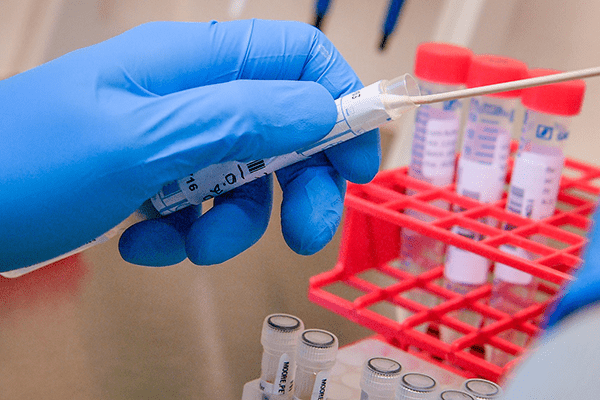 Dr. Phil Dormitzer, Vice President and Chief Scientific Officer for Viral Vaccines at Pfizer, Talks With RCBJ About Coronavirus
Dr. Phil Dormitzer, Vice President and Chief Scientific Officer for Viral Vaccines at Pfizer, Talks With RCBJ About Coronavirus
What do scientists understand about the COVID-19 virus?
The current pandemic is caused by a virus that is called SARS-CoV-2; SARS-CoV-2 is a coronavirus. The disease caused by SARS-CoV-2 is called COVID-19. The structure of the virus and sequence are well understood, and we believe that we have a good understanding of the protective immunity required to prevent COVID-19 and how a vaccine should be designed. Multiple vaccine approaches are currently being advanced into the clinic.
What has thus far been discovered since the outbreak?
We now know much more about the disease caused by this illness. Many of the basic scientific tools used to study the virus, like strains that grow well in cell culture, specific antibodies against the virus, and animal models of the infection are being developed. However, there is still much to learn.
Is this a deadlier strain that the flu?
The answer to this question is complex, and the final answer remains uncertain. The following statistics provide some perspective. During this flu season, as of March 21, 2020, the CDC estimates that influenza has killed 24,000-62,000 Americans, including 155 children (https://www.cdc.gov/flu/about/burden/preliminary-in-season-estimates.htm). As of March 28, 2020, the CDC estimates that COVID-19 has killed 1,668 Americans (https://www.cdc.gov/coronavirus/2019-ncov/cases-updates/cases-in-us.html). Childhood deaths due to COVID-19 have been very rare.
However, this comparison does not tell the whole story. First, the northern hemisphere flu season is currently winding down, while COVID-19 is in a period of exponential spread, and we don’t know how many Americans will be infected and killed by COVID-19 before the virus that causes the disease is contained. Second, among the elderly who have become sick enough to have been tested, the mortality rate can be high – 10-27% in those 85 years of age or older and 3-11% in those 65-84 years of age (MMWR 69:343-346). The big limitation of such “case fatality rate” estimates for COVID-19 is that, based on the data we have seen thus far, there are probably many people who have been infected by the virus but have not become sick enough to be tested. This means that the true case fatality rate may be much lower than the current estimates.
Indeed, this comparison does not take into account the fatality rates for more deadly strains of flu, which sometimes arise. As high as the reported COVID-19 case fatality rates are among the elderly, they pale compared to the case fatality rates reported for people of all ages who become infected with the most deadly strains of flu, such as highly pathogenic H5N1, which kills ~60% of those who become sick enough to be tested. Fortunately, such very deadly flu strains rarely infect humans and we have never seen sustained transmission between humans. Nevertheless, preparedness for a highly pathogenic influenza pandemic should be a high priority to avoid an event that could make the current situation seem tame by comparison.
What is Pfizer doing to research/find a vaccine for the virus? Is it part of the international team of scientists working on the issue? What kind of collaborations do they have going?
We are working with our partner BioNTech on developing its vaccine candidates which are based on BioNTech’s mRNA platforms. mRNA vaccines are a new approach to immunization that have the advantage that a vaccine candidate can be developed quickly for clinical testing. Based on our knowledge of other coronaviruses that have caused outbreaks like those that caused SARS and MERS, and the efforts to develop vaccines against those coronavirus diseases by the scientific community, we have a good idea how to develop a vaccine to prevent COVID-19. We are working to advance multiple mRNA candidates into the clinic in the next month, first in Germany, followed soon thereafter in the US. In addition to BioNTech, we are connected to a large number of institutions with years’ long experience in the coronavirus field. Some of these centers have specialized assays and models to measure vaccine candidate responses in animals and humans that we would hope to access if helpful to advance this important effort. Given this pandemic and the health care crisis caused by it, we see unprecedented private and public partnerships and collaborations, which include private companies helping each other to advance potential solutions to address COVID-19.
How difficult is it to find a vaccine for a “new” virus. Compare to former cases. Is it possible that a virus is unresponsive to a vaccine?
Whether or not a new virus is vaccine preventable depends on the virus. In general, though many viruses are amenable to vaccine development, others have eluded scientific efforts. For example, a vaccine has not been developed to prevent HIV despite decades long vaccine development efforts. Some viruses, like rhinoviruses (a cause of the common cold), have too many variants that cause disease to make vaccine development practical. That said, new scientific discoveries can make it possible to develop vaccines against viruses that previously eluded control by immunization. A great example is respiratory syncytial virus (RSV – the leading cause of severe respiratory infections in infants). This virus has eluded vaccine development efforts since the 1960’s. However, new scientific discoveries, have supported development of a vaccine candidate by Pfizer that is now in clinical trials.
In lieu of a vaccine, are there any drugs now, or being researched to deal with COVID-19?
Yes, we are aware of numerous potential approaches to address the disease COVID-19, including antibody therapy (both monoclonal and plasma derived), antiviral drugs, and treatments that temper the destructive immune responses in patients that are, at least in part, responsible for the severity of COVID-19.
What does it look like in the research lab right now: have they ramped up shifts, are they working around the clock, how has life inside their labs changed since the outbreak?
Researchers across the globe are working 24/7 to try to find solutions to stem the spread of SARs-CoV-2. Because there was just a few months between the first report of the disease to a full blown global pandemic, multiple parallel approaches are being pursued. Needless to say, this is stressful for researchers and, even more so for the medical professionals treating these patients. In addition, because of the pandemic, movement of people is restricted, which makes remote communications more critical than ever. Researcher who have to go into laboratories or health care providers who must work in hospital settings are under constant fear of contracting the disease themselves. For example, in Pfizer’js Pearl River laboratories, we are maintaining rigorous precautions, including social distancing required in the workplace, to keep our colleagues as safe as possible. Despite these challenges, there is optimism and an incredible sense of urgency both in private and public settings to do all that is possible to solve this public health crisis. Pfizer colleagues, together with our partners are working tirelessly on solutions.
How is the COVID-19 pandemic the same/different from other pandemics in the last two decades.
The most recent pandemic before the COVID-19 pandemic was the 2009 H1N1 pandemic. The CDC estimates that, in the United States between April 2009 and February 13, 2010, H1N1 pandemic flu infected about 59 million Americans and killed about 12,000 (https://www.cdc.gov/H1N1flu/estimates/April_February_13.htm). Although these numbers are far higher than the current number of infections and deaths from COVID-19, the current pandemic is still in its early stages, and the comparison could look very different a few months from now. One other difference is that the current pandemic seems to affect the elderly more than other populations, although younger people do become sick and sometimes die. The 2009 pandemic was less severe than expected among the elderly, who may have had immunity from infections by related influenza strains that circulated early in the 20th century, but was especially deadly for pregnant women.
The two previous recent outbreaks of severe coronavirus disease, SARS (starting in 2003) and MERS (starting in 2012), never became pandemics. SARS was contained completely. MERS has been reduced to a low level in the Middle East, with no more sustained human to human transmission but occasional isolated human infections or clusters of infection following re-introductions of the virus from a reservoir in camels.
Dr. Phil Dormitzer, Vice President and Chief Scientific Officer for Viral Vaccines based at Pearl River











